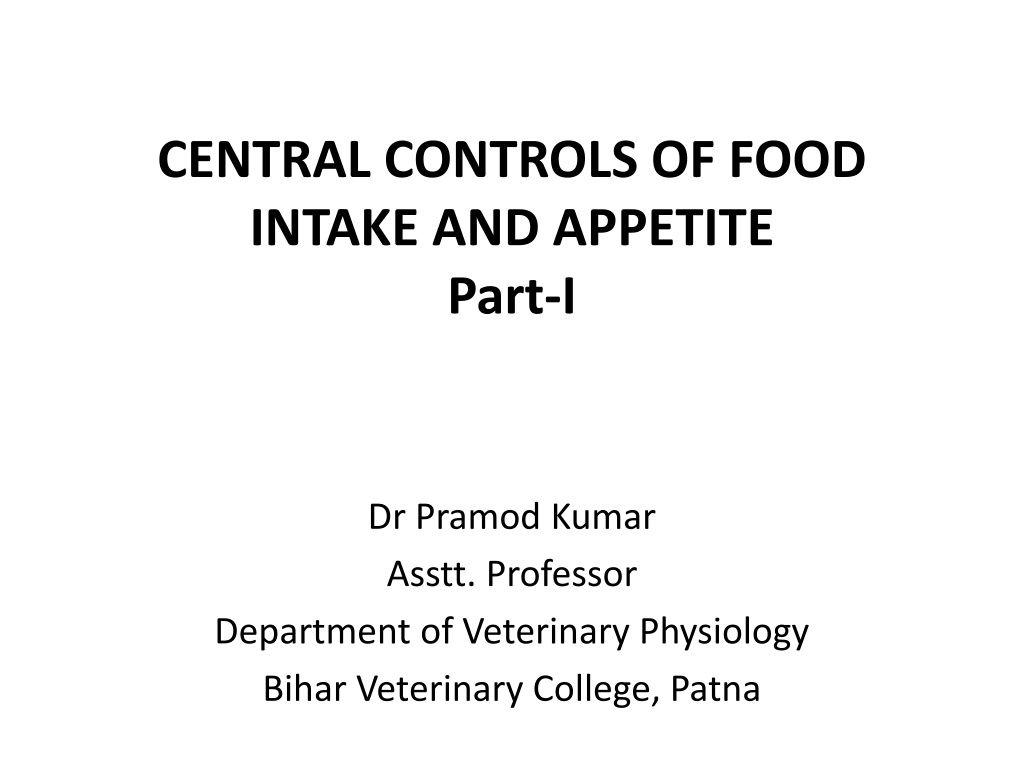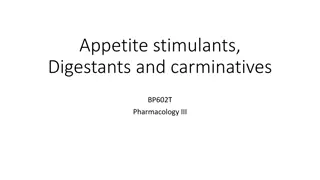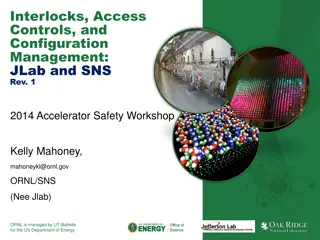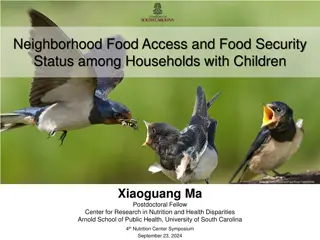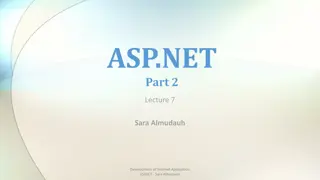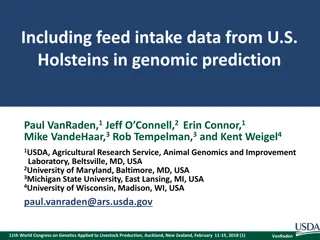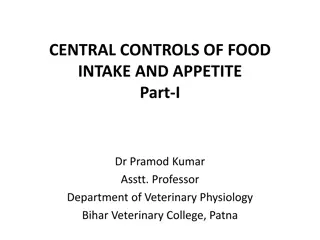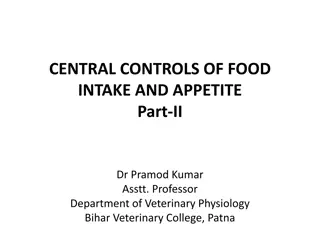Understanding the Central Controls of Food Intake and Appetite in Animals
Nutrition is essential for animal health and growth, with food nutrients being the main energy source through digestion and absorption processes. The regulation of animal nutrition involves various tissues and organs. Animals acquire nutrients through specialized digestive systems, breaking down food into smaller molecules for distribution throughout the body. Different types of feeders exist, each with unique feeding mechanisms. The stages of the digestive process include secretion, digestion, absorption, and elimination.
Download Presentation

Please find below an Image/Link to download the presentation.
The content on the website is provided AS IS for your information and personal use only. It may not be sold, licensed, or shared on other websites without obtaining consent from the author. Download presentation by click this link. If you encounter any issues during the download, it is possible that the publisher has removed the file from their server.
E N D
Presentation Transcript
CENTRAL CONTROLS OF FOOD INTAKE AND APPETITE Part-I Dr Pramod Kumar Asstt. Professor Department of Veterinary Physiology Bihar Veterinary College, Patna
Nutrition is defined as the process of providing and obtaining the food necessary for the health and growth of animals. Food nutrients are utilized as the main energy source by an animal via various processes, including digestion and absorption in the digestive transport and metabolism Regulation of animal nutrition is associated with the functions of various tissues and organs in animals. The relationship immunology, nutritional nutrigenomics is describing the development of recent advances in treatments and specific metabolic disease. tract, the blood cells. in between disease and
Introduction Animals mostly ingest their food as large, complex molecules that must be broken down into smaller molecules (monomers) that can then be distributed throughout the body of every cell. This vital function is accomplished by a series of specialized organs that comprise the digestive system. Single-celled organisms can directly take in nutrients from their outside environment while Multicellular animals have developed specialized structures for obtaining and breaking down their food.
Heterotroph animals absorb nutrients or ingest food sources. Ingestive eaters use their mouth to ingest food. Absorptive tapeworms, live in a digestive system of another animal and absorb nutrients from that animal directly through their body wall. Filter feeders, such as oysters and mussels collect small organisms and particles from the surrounding water. Substrate feeders, such as earthworms and termites eat the material (dirt or wood) they burrow through. Fluid feeders, such as aphids pierce the body of a plant or animal and withdraw fluids. feeders such as
Stages in the Digestive Process Food for the most part consists of various organic macromolecules such as starch, proteins, and fats. These molecules are polymers made of individual monomer units. Breaking these large molecules into smaller components involves: o secretion: release of digestive juices in response to a specific stimulus o digestion: breakdown component so as to cross the plasma membrane o absorption: passage of the molecules into the body's interior and passage throughout the body of food into molecular
o elimination: removal of undigested food and wastes o Three processes occur during what we loosely refer to as "digestion". Digestion proper, which is the mechanical and chemical breakdown of food into particles/molecules small enough to pass into the blood. Absorption is the passage of food monomers into the blood stream. Assimilation is the passage of the food molecules into body cells.
As the digestive tract is one of the most important immune organs and adipose tissue is the biggest endocrine organ in the animal body, immunology and indispensable view points in the study of animal nutrition. In obesity, marked aberration of adipokine (adipocytokine) secretion in visceral fat together with an imbalance in the production of pro and anti-inflammatory adipokines are critical in the development of various aspects of the metabolic syndrome, resistance. endocrinology are such as insulin
Plasma hormone concentrations can accompany changes in the immune states of animals. Monocyte chemoattractant protein-1 (MCP-1) is secreted from white adipose tissue in obesity and contributes to accumulation and insulin resistance by inducing a chronic inflammatory state . Adipose tissues in obese animals are altered to secrete other pro- inflammatory cytokines such as TNF- , MCP-1, and IL-6 , which cause a persistent low-grade inflammation. Obesity imbalance in the immune reaction of animals. tissue macrophage also induces an
Nutrigenomics Nutrigenomics genomics to study the effects of foods and food constituents on gene expression. It has also been described as the influence of genetic variation on nutrition, where gene expression or single nucleotide polymorphisms (SNPs) are correlated with a nutrient s absorption, elimination or biological effects. Nutrigenomics can lead to the development of effective foods for many diseases in animals for instance, weight reducing diets that contain optimal constituents for obese animals. is a branch of nutritional metabolism,
Metabolomics Metabolomics is the scientific study of chemical processes involving metabolites. Metabolomics is the systemic study of the unique chemical fingerprints that specific cellular processes leave behind. The metabolome represents the collection of all metabolites in a biological cell, tissue, organ or organism. Measurement of metabolites in animals with metabolic disorders can clarify the underlying cause of the disorder, such that metabolomics is very effective for the diagnosis of disease in animals.
Ruminant measurement of fermentation products in the rumen and is very important for investigation of health in ruminants. Exhaustive investigation of the effects of nutrients on plasma metabolite concentrations will be further developed as nutrimetabolomics for nutrition and metabolism nutrigenomic studies for improvement of animal health and for development of new diagnostic and treatment methods for nutritional diseases. metabolomics tends with the animals. Animal encourages
Treatment of metabolic disorder includes the development of customized food, supplements and drugs. Recently, good candidates of supplements and drugs for treating obesity in human medicine were developed and these compounds will now be studied and utilized in veterinary medicine. Licorice flavonoids have antioxidative and anti-inflammatory activities and are very effective for treating obesity in animals. Apoptosis inhibitor of macrophage (AIM) is a macrophage-derived blood protein that plays a key role in the pathogenesis of atherosclerosis, metabolic diseases and autoimmune diseases. The regulation of blood AIM levels has the potential to serve as a next generation therapy against these inflammatory diseases obesity-associated
